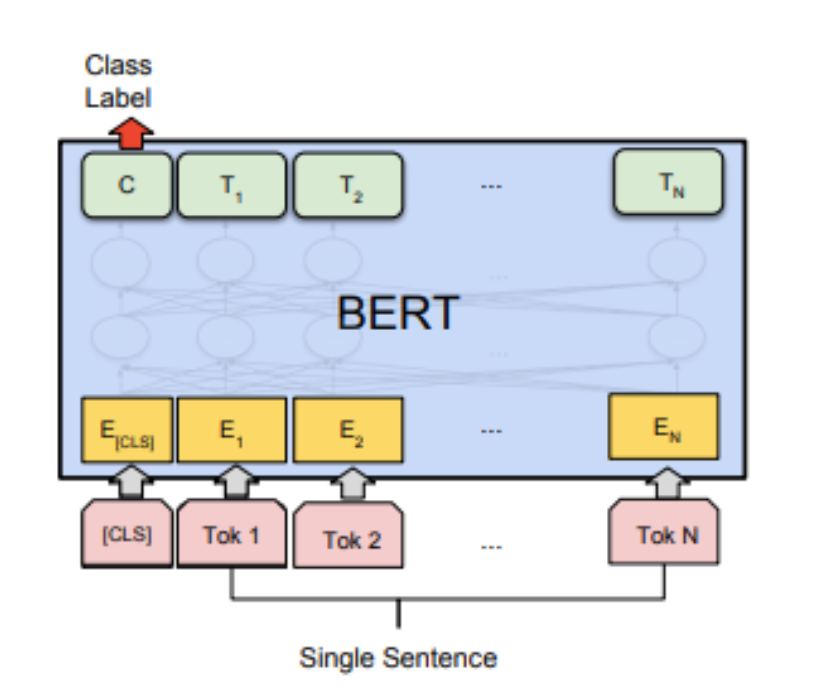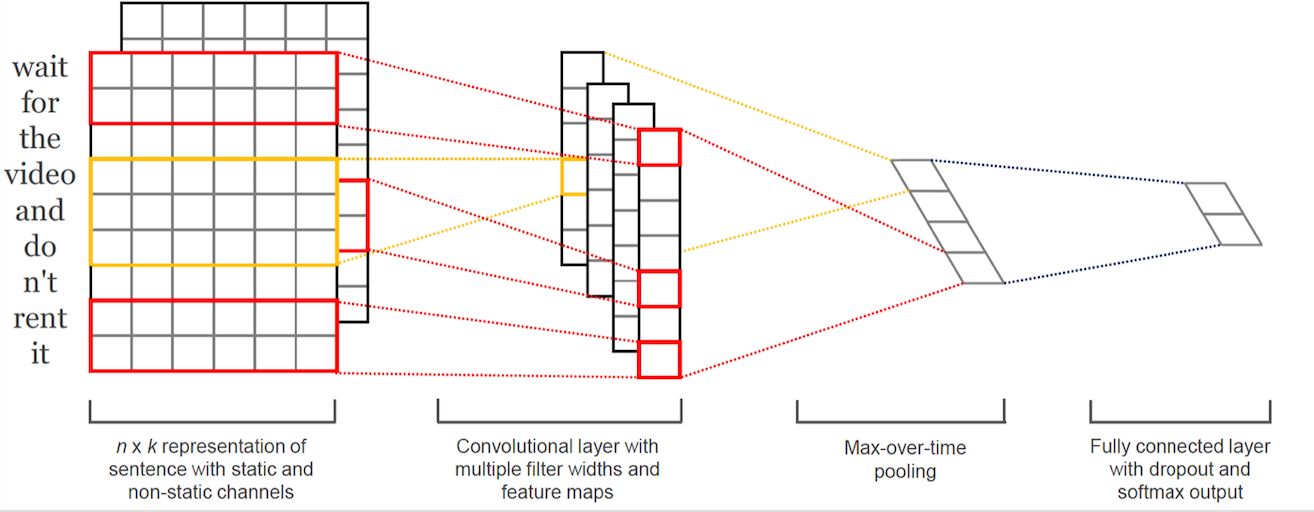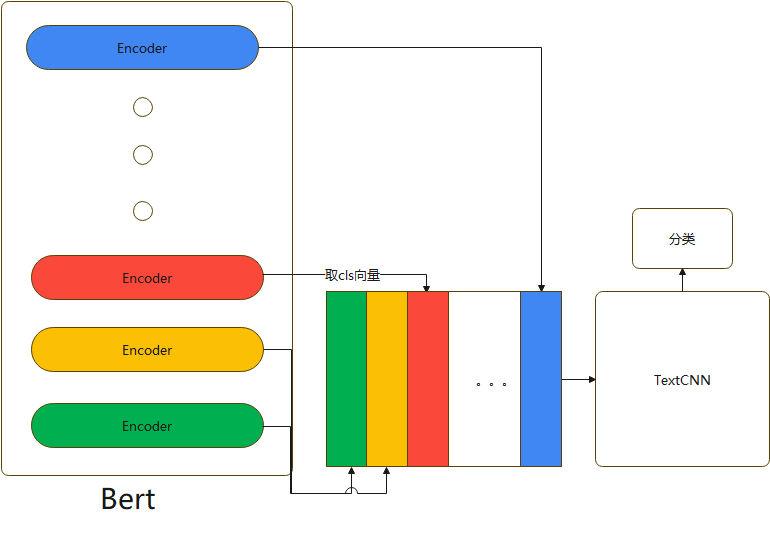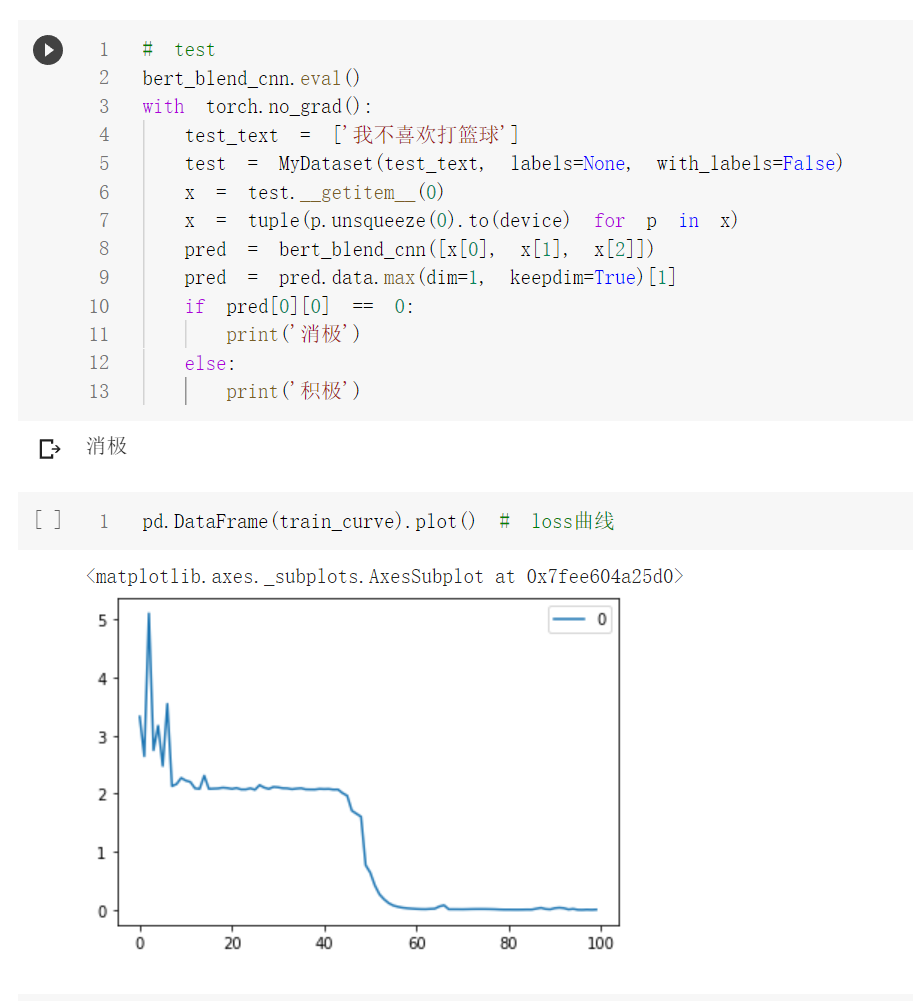Bert文本分类实践(二):魔改Bert,融合TextCNN的新思路
写在前面
文本分类是nlp中一个非常重要的任务,也是非常适合入坑nlp的第一个完整项目。虽然文本分类看似简单,但里面的门道好多好多,博主水平有限,只能将平时用到的方法和trick在此做个记录和分享,希望各位看官都能有所收获。并且尽可能提供给出简洁,清晰的代码实现。
本文采用的文本分类模型是基于Bert和TextCNN的方法进行魔改,在博主实际的有关文本分类的工作中取得了F1值超越Bert基础模型近4%的效果。大家可以用自己的数据尝试一下哦 - _ *
有关于Bert文本分类baseline版本请参考此处
第一部分
模型
Bert模型是Google在2018年10月发布的语言表示模型,一经问世在NLP领域横扫了11项任务的最优结果,可谓风头一时无二。有关于Bert中transformer的模型细节,推荐看这篇。在此不做赘述。

Bert文本分类模型常见做法为将bert最后一层输出的第一个token位置(CLS位置)当作句子的表示,后接全连接层进行分类。

在Bert问世前,TextCNN在文本分类模型中占据了举足轻重的位置,源于Cnn网络可以很有效的捕捉文本序列中的n-gram信息,而分类任务从本质上讲是捕捉n-gram排列组合特征,捕捉关键词,内容,还是句子的上层语义,在句子中均是以n-gram特征的形式存在的。博主在做完Bert和TextCNN的实验惊奇的发现,Bert往往可以对一些表述隐晦的句子进行更好的分类,TextCNN往往对关键词更加敏感。所以博主魔改了一下模型,将Bert与TextCNN的思想融合在一起。

Bert-Base除去第一层输入层,有12个encoder层,每个encode层的第一个token(CLS)向量都可以当作句子向量,我们可以抽象的理解为,encode层越浅,句子向量越能代表低级别语义信息,越深,代表更高级别语义信息。我们的目的是既想得到有关词的特征,又想得到语义特征,模型具体做法是将第1层到第12层的CLS向量,作为CNN的输入,分类。
话不多说我们直接看代码!
第二部分
pytorch代码实现
# -*- coding:utf-8 -*-
# bert融合textcnn思想的Bert+Blend-CNN
# model: Bert+Blend-CNN
# date: 2021.10.11 18:06:11
import os
import numpy as np
import pandas as pd
import torch
import torch.nn as nn
import torch.utils.data as Data
import torch.nn.functional as F
import torch.optim as optim
import transformers
from transformers import AutoModel, AutoTokenizer
import matplotlib.pyplot as plt
train_curve = []
device = torch.device('cuda' if torch.cuda.is_available() else 'cpu')
# # 定义一些参数,模型选择了最基础的bert中文模型
batch_size = 2
epoches = 100
model = "bert-base-chinese"
hidden_size = 768
n_class = 2
maxlen = 8
encode_layer=12
filter_sizes = [2, 2, 2]
num_filters = 3
# data,构造一些训练数据
sentences = ["我喜欢打篮球", "这个相机很好看", "今天玩的特别开心", "我不喜欢你", "太糟糕了", "真是件令人伤心的事情"]
labels = [1, 1, 1, 0, 0, 0] # 1积极, 0消极.
class MyDataset(Data.Dataset):
def __init__(self, sentences, labels=None, with_labels=True,):
self.tokenizer = AutoTokenizer.from_pretrained(model)
self.with_labels = with_labels
self.sentences = sentences
self.labels = labels
def __len__(self):
return len(sentences)
def __getitem__(self, index):
# Selecting sentence1 and sentence2 at the specified index in the data frame
sent = self.sentences[index]
# Tokenize the pair of sentences to get token ids, attention masks and token type ids
encoded_pair = self.tokenizer(sent,
padding='max_length', # Pad to max_length
truncation=True, # Truncate to max_length
max_length=maxlen,
return_tensors='pt') # Return torch.Tensor objects
token_ids = encoded_pair['input_ids'].squeeze(0) # tensor of token ids
attn_masks = encoded_pair['attention_mask'].squeeze(0) # binary tensor with "0" for padded values and "1" for the other values
token_type_ids = encoded_pair['token_type_ids'].squeeze(0) # binary tensor with "0" for the 1st sentence tokens & "1" for the 2nd sentence tokens
if self.with_labels: # True if the dataset has labels
label = self.labels[index]
return token_ids, attn_masks, token_type_ids, label
else:
return token_ids, attn_masks, token_type_ids
train = Data.DataLoader(dataset=MyDataset(sentences, labels), batch_size=batch_size, shuffle=True, num_workers=1)
class TextCNN(nn.Module):
def __init__(self):
super(TextCNN, self).__init__()
self.num_filter_total = num_filters * len(filter_sizes)
self.Weight = nn.Linear(self.num_filter_total, n_class, bias=False)
self.bias = nn.Parameter(torch.ones([n_class]))
self.filter_list = nn.ModuleList([
nn.Conv2d(1, num_filters, kernel_size=(size, hidden_size)) for size in filter_sizes
])
def forward(self, x):
# x: [bs, seq, hidden]
x = x.unsqueeze(1) # [bs, channel=1, seq, hidden]
pooled_outputs = []
for i, conv in enumerate(self.filter_list):
h = F.relu(conv(x)) # [bs, channel=1, seq-kernel_size+1, 1]
mp = nn.MaxPool2d(
kernel_size = (encode_layer-filter_sizes[i]+1, 1)
)
# mp: [bs, channel=3, w, h]
pooled = mp(h).permute(0, 3, 2, 1) # [bs, h=1, w=1, channel=3]
pooled_outputs.append(pooled)
h_pool = torch.cat(pooled_outputs, len(filter_sizes)) # [bs, h=1, w=1, channel=3 * 3]
h_pool_flat = torch.reshape(h_pool, [-1, self.num_filter_total])
output = self.Weight(h_pool_flat) + self.bias # [bs, n_class]
return output
# model
class Bert_Blend_CNN(nn.Module):
def __init__(self):
super(Bert_Blend_CNN, self).__init__()
self.bert = AutoModel.from_pretrained(model, output_hidden_states=True, return_dict=True)
self.linear = nn.Linear(hidden_size, n_class)
self.textcnn = TextCNN()
def forward(self, X):
input_ids, attention_mask, token_type_ids = X[0], X[1], X[2]
outputs = self.bert(input_ids=input_ids, attention_mask=attention_mask, token_type_ids=token_type_ids) # 返回一个output字典
# 取每一层encode出来的向量
# outputs.pooler_output: [bs, hidden_size]
hidden_states = outputs.hidden_states # 13*[bs, seq_len, hidden] 第一层是embedding层不需要
cls_embeddings = hidden_states[1][:, 0, :].unsqueeze(1) # [bs, 1, hidden]
# 将每一层的第一个token(cls向量)提取出来,拼在一起当作textcnn的输入
for i in range(2, 13):
cls_embeddings = torch.cat((cls_embeddings, hidden_states[i][:, 0, :].unsqueeze(1)), dim=1)
# cls_embeddings: [bs, encode_layer=12, hidden]
logits = self.textcnn(cls_embeddings)
return logits
bert_blend_cnn = Bert_Blend_CNN().to(device)
optimizer = optim.Adam(bert_blend_cnn.parameters(), lr=1e-3, weight_decay=1e-2)
loss_fn = nn.CrossEntropyLoss()
# train
sum_loss = 0
total_step = len(train)
for epoch in range(epoches):
for i, batch in enumerate(train):
optimizer.zero_grad()
batch = tuple(p.to(device) for p in batch)
pred = bert_blend_cnn([batch[0], batch[1], batch[2]])
loss = loss_fn(pred, batch[3])
sum_loss += loss.item()
loss.backward()
optimizer.step()
if epoch % 10 == 0:
print('[{}|{}] step:{}/{} loss:{:.4f}'.format(epoch+1, epoches, i+1, total_step, loss.item()))
train_curve.append(sum_loss)
sum_loss = 0
# test
bert_blend_cnn.eval()
with torch.no_grad():
test_text = ['我不喜欢打篮球']
test = MyDataset(test_text, labels=None, with_labels=False)
x = test.__getitem__(0)
x = tuple(p.unsqueeze(0).to(device) for p in x)
pred = bert_blend_cnn([x[0], x[1], x[2]])
pred = pred.data.max(dim=1, keepdim=True)[1]
if pred[0][0] == 0:
print('消极')
else:
print('积极')
pd.DataFrame(train_curve).plot() # loss曲线
测试单条样本结果:

代码链接:
jupyter版本:https://github.com/PouringRain/blog_code/blob/main/nlp/Bert_Blend_CNN.ipynb
py版本:https://github.com/PouringRain/blog_code/blob/main/nlp/bert_blend_cnn.py
喜欢的话,给萌新的github仓库一颗小星星哦……^ _^



【推荐】编程新体验,更懂你的AI,立即体验豆包MarsCode编程助手
【推荐】凌霞软件回馈社区,博客园 & 1Panel & Halo 联合会员上线
【推荐】抖音旗下AI助手豆包,你的智能百科全书,全免费不限次数
【推荐】博客园社区专享云产品让利特惠,阿里云新客6.5折上折
【推荐】轻量又高性能的 SSH 工具 IShell:AI 加持,快人一步